It has been a great pleasure to spend the last few months cataloging David’s violins and seeing so many interesting American instruments. David’s collection is vast and varied; it includes all of the famous American makers but its real strength is that it also includes hundreds of lesser-known luthiers, like self-taught amateurs who might have only made a few violins for friends and family. David’s attention and care to these violins over the years and his input in preparation for the upcoming auctions have been invaluable.
While cataloging this collection I was struck by the great variety of ways in which American makers labeled their instruments: so many personal styles and almost all of them deviate from the established traditions of European violinmaking in one way or another. All violin labels are autobiographical to a certain extent; some tell us a maker’s family or mentorship lineage, many tell us where a maker is from, sometimes we even learn the location of their shop. What struck me as unique to this collection of instruments, however, is a focus on visual branding and uniqueness. Although certain conventions of classical European labeling remain, most 19th and 20th century American makers added their own personal flair: bold brands, imagery, typefaces, autobiographies and sometimes poetry. Perhaps the influence of American-style advertising, coupled with the availability and affordability of new printing technology provoked these bold American labels that we find in the Bromberg collection.
I’ve prepared some images of my favorite labels from the current T2 sale plus some commentary. I hope you enjoy these as much as I did.

Carl Sturm, Chicago, 1940
August 2025 T2: Lot 277
Carl Sturm was active in Chicago in the early 20th century. We know of his viola “#1”, dated 1939 on a printed label. From this we can deduce that his output and operation was quite small, considering only eight violins were made in the 16 years since his start around 1924. I like the idea that Sturm went out of his way to handwrite a label for a violin dedicated to a friend. While we don’t see a bold and flashy label like some of the ones to come, this label offers a wonderful insight into the intentions and dealings of a lesser known maker from 20th century America.
"To my dear friend Tharvald I hope you will enjoy playing as I did making it for you. #8. 1940. Carl Sturm."

George A. Ostertag, Niagara Falls, 1904
December 2025 T2
The next label that caught my eye was this one from a violin made by George A. Ostertag in Niagara Falls in 1904. There’s something charming about the label displaying a nice image of the falls, rather than an insignia or a portrait. It not only shows Ostertag’s pride for his location, but it invites you to his workshop while you read.
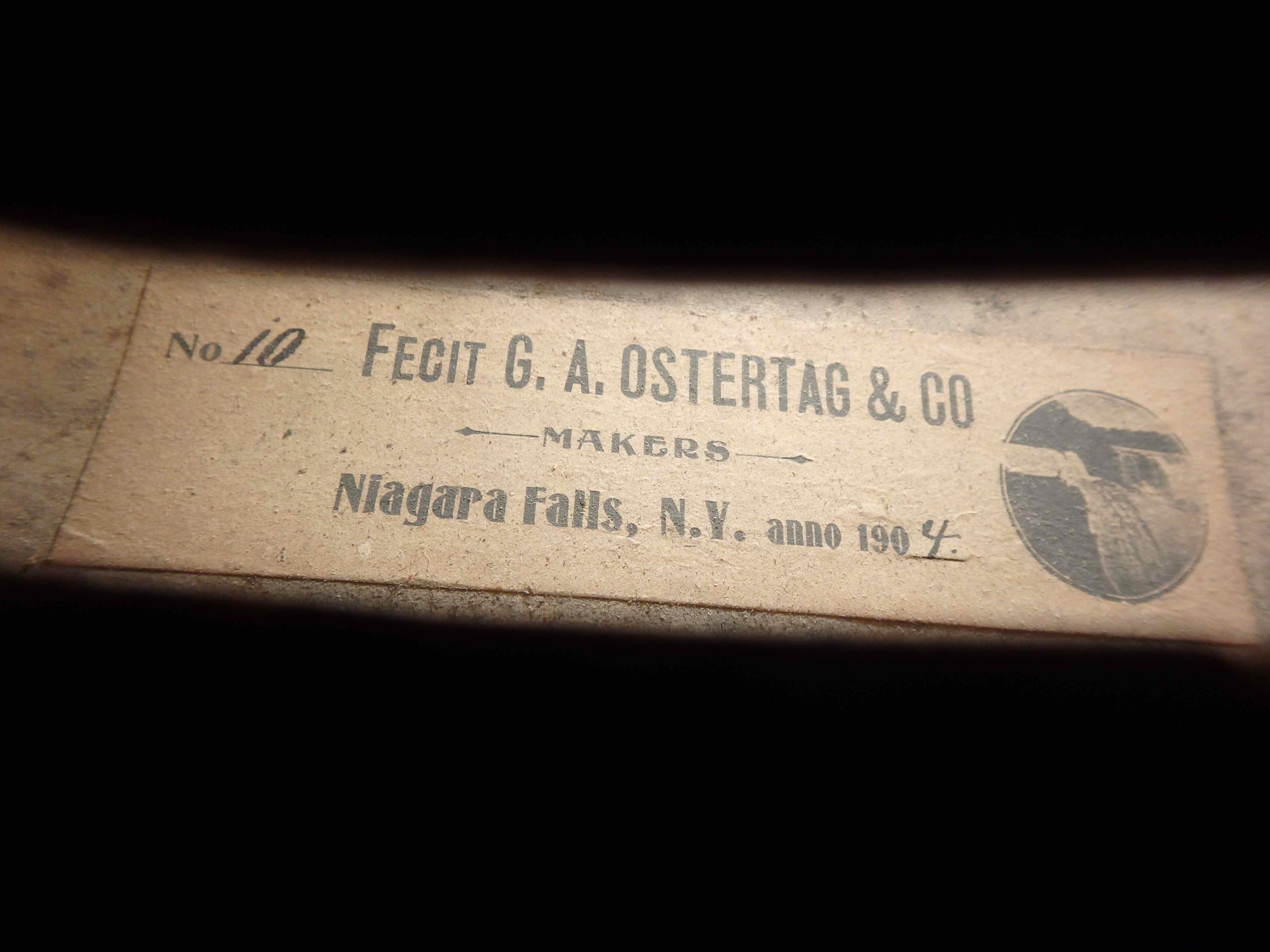
“Fecit G. A. Ostertag & Co. Makers Niagara Falls, N. Y. Anno 1904 No. 10.”

Some labels took a more poetic approach…
A. W. Kaufmann, San Jose, 1905
October 2025 T2: Lot 299
What I love more than the text is the fact Kaufmann wasn’t afraid to include a contemplative bench photo. Of all of the labels in the collection, this one might be the most impressive in its print quality, descriptiveness, aesthetics, and uniqueness in branding, especially considering it was made in 1905! For an amateur maker, Kaufmann gave careful consideration to a branding opportunity of a photo and inspirational passage on the label.
"Made from the body of a daughter of the forest and given a voice by the hands of a son of the mother whose praises I shall ever sing. A. W. Kaufmann, San Jose, 1905."

Robert Glier, Cincinnati, 1901
December 2025 T2
Speaking of artsy labels, we shouldn’t let Robert Glier’s violin-outline label go unnoticed. Typical of the instruments he made for Wurlitzer, this label has a violin-shaped outline, even including true-to-scale scale f-holes, laid out with an adaption of the Blackletter typeface. The date and production number are finished with a bold red ink.
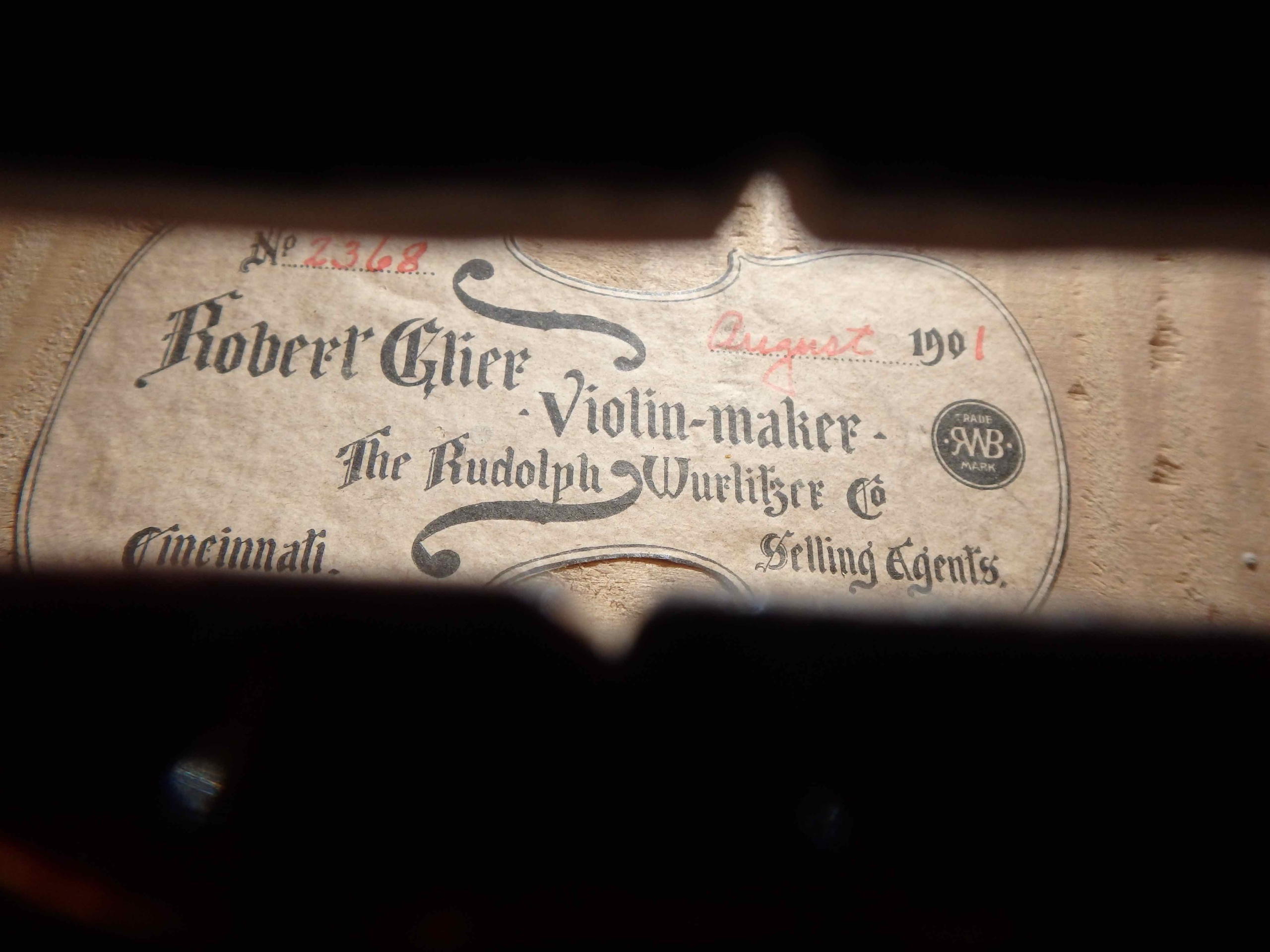
“Robert Glier Violin-Maker The Rudolph Wurlitzer Co. Selling Agents. Cincinnati. August 1901 No. 2368.”

Jacob Beyer, Brooklyn, 1894
August 2025 T2: Lot 275
While we’re on the topic of aesthetics, the award for best design will be given to Jacob Beyer for his label in his 1894 violin, No. 4. Not only does he employ the brilliant efficiency of only one capital B to write his last name and city, but he chooses a fascinating typeface that is unlike any other label I’ve seen. The unique lettering style and inconsistent inking suggests Beyer’s labels were produced at a small scale, perhaps locally.
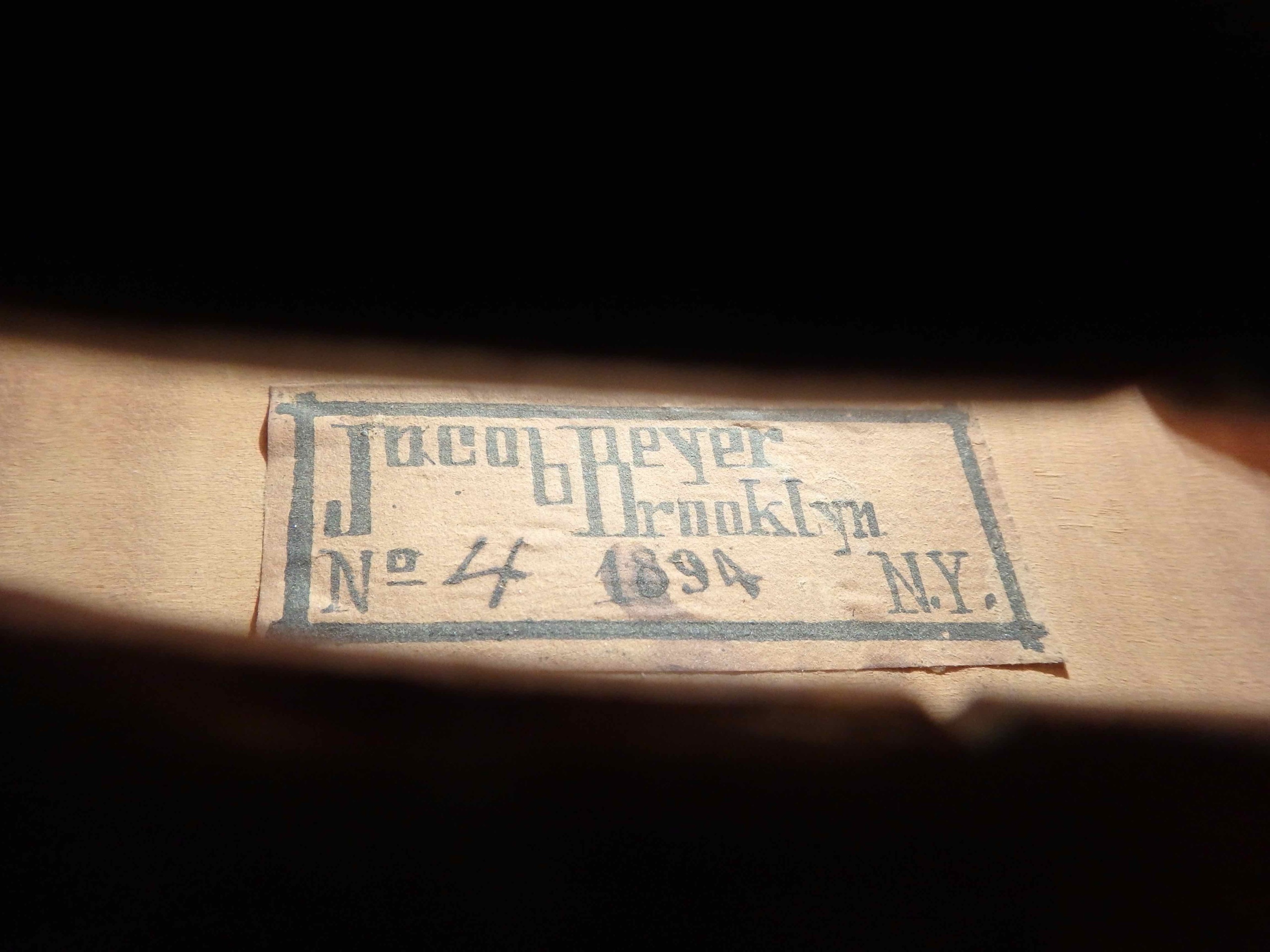
“Jacob Beyer Brooklyn, N. Y. No. 4 1894.”

Henry Latimer, Hudson, 1897
December 2025 T2
Beyer wasn’t the only maker who chose to spruce up his label with an interesting font. Henry Latimer utilized a unique sans serif font that incorporates a slight art-nouveau feeling, especially in the delicate ornamentation of the L, A, and E letters.
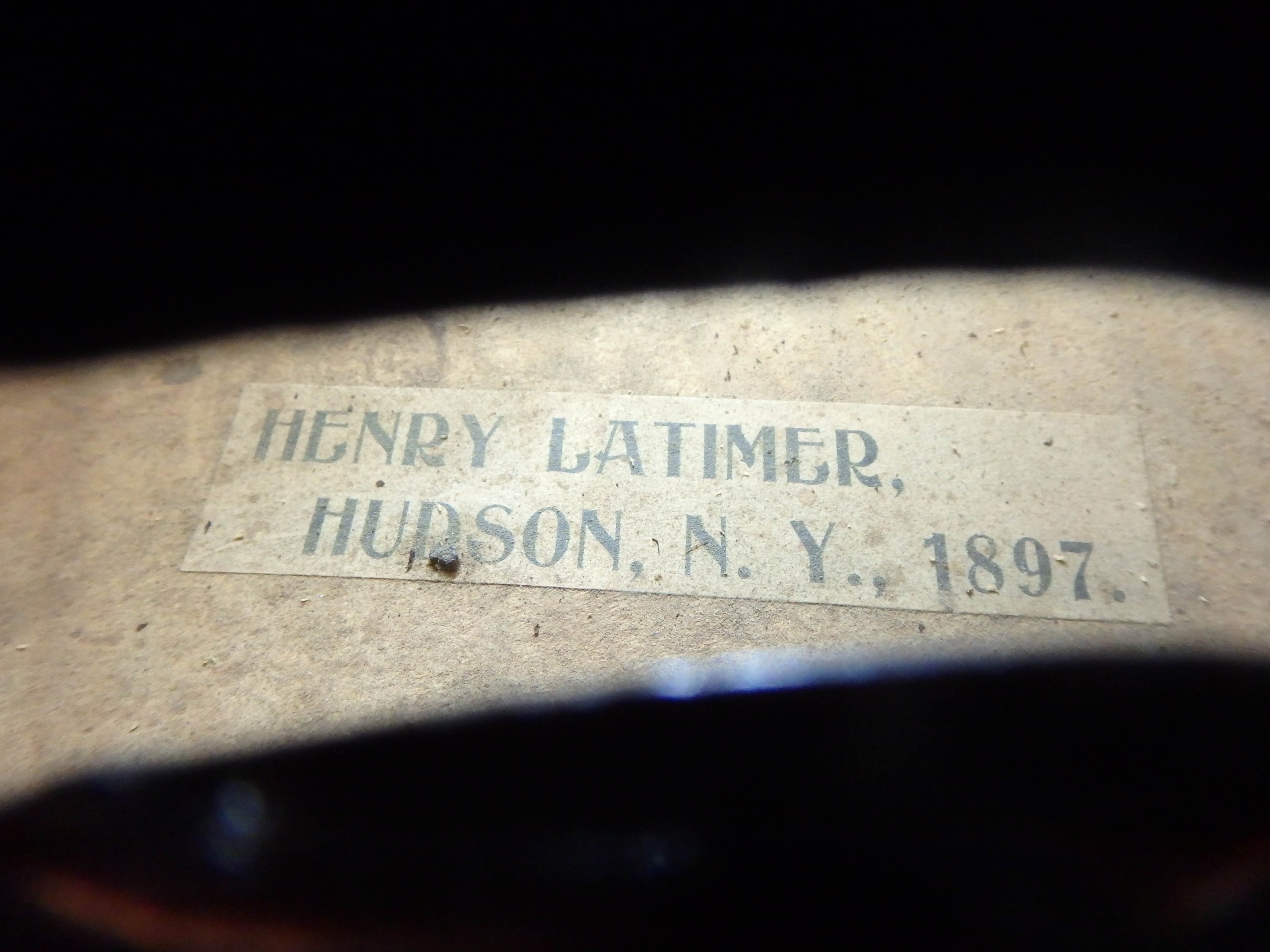
“Henry Latimer, Hudson, N. Y. 1897.”

Daniel Wood, Cohasset, late 19th Century
December 2025 T2
Daniel Wood’s label employs two distinct fonts. For his name, he decided to use a wide block-serifed font in all capitals. This is a bold display of his name, which transmits a clear and professional message. The location uses a drop-shadow serif typeface, which connotes an element of prestige and elegance. This practice was common in the mid-late 19th century and the label was likely produced by a commercial printer, judging from the variety of fonts and the ornamental border.
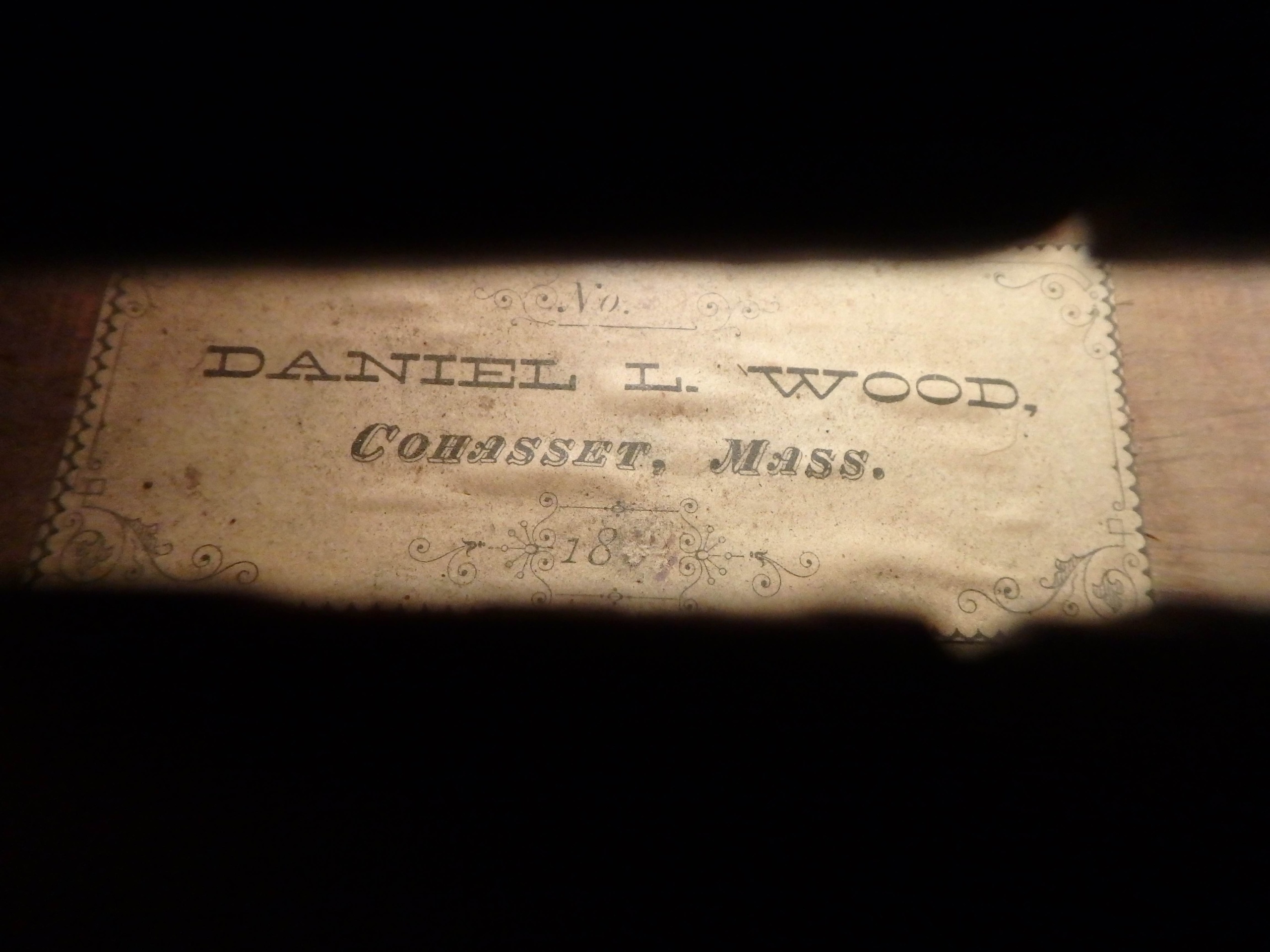
“Daniel L. Wood, Cohasset, Mass. 18…4 No…7.”

Orville Moses Robinson, St. Paul, 1901
October 2025 T2: Lot 277
O. M. Robinson’s label introduces an interesting contradiction in its aesthetic. The typeface demonstrates a Victorian design aesthetic in its detail, decorativeness, and formality. While few European labels look anything like this, clearly there was an attempt to conjure European tradition with this label. This reminds us that in the eyes of Americans, fanciness can be perceived as Europeanness. The evocation of Victorian aesthetics through the imagery, fonts, and ornamentation demonstrates an attempt to convey that quality.
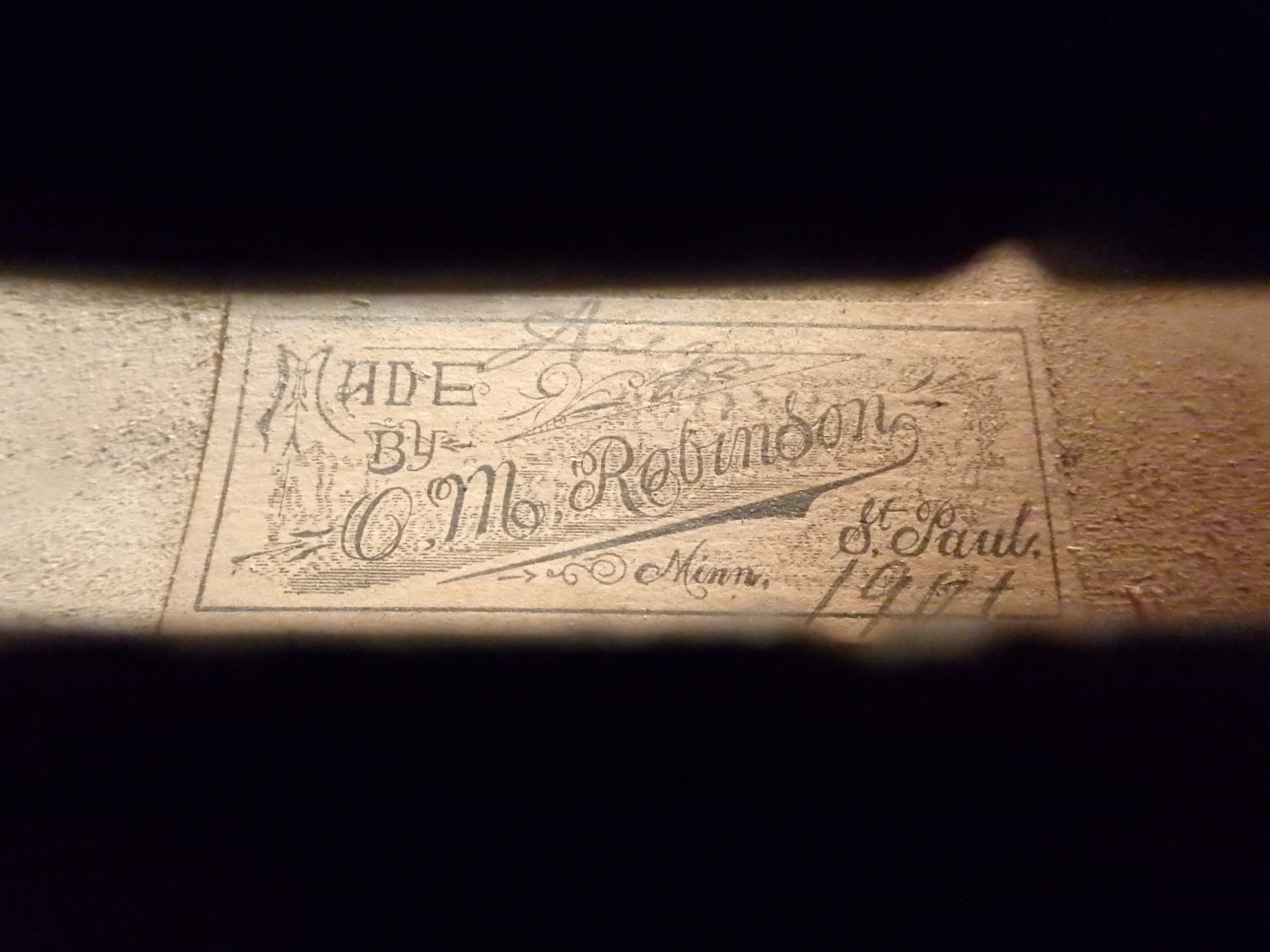
“Made by O. M. Robinson St. Paul, Minn. Aug 1901.”

Gustav Fassauer Ferron, Chicago, 1917
October 2025 T2: Lot 297
G. F. Ferron’s label stands out to me; the art-deco serif text is bold, exciting, and capitalized, the alliteration, Fassauer Ferron Fecit, grabs your attention, and the back-to-back “FF” icon rounds out the label and contributes, in a way, to the alliteration as well. Ferron, having received his training in Germany before emigrating to the U.S., shows us a great example of a label that sticks to the traditions – maker, fecit, city, date – with a fresh and modern approach.
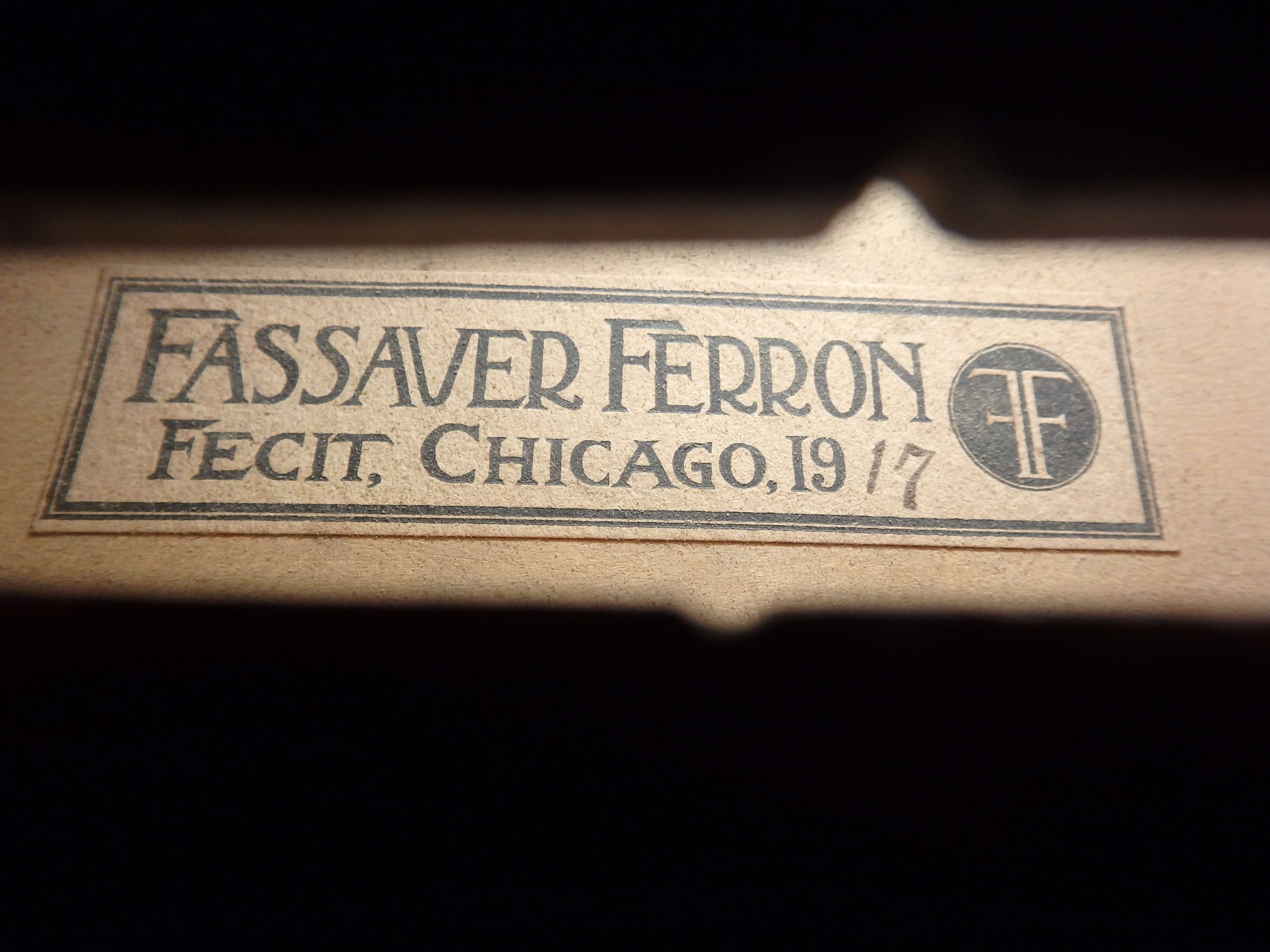
“Fassauer Ferron Fecit, Chicago, 1917.”

Harold A. Pinney, Plymouth, 1936
December 2025 T2
New ideas seem to have been everywhere with violin makers in the New World. Harold Pinney took transparency to a new level by writing the price of his violin on its label. I appreciate this very much and I also wonder how much that price was leveraged in subsequent sales of the violin. If I was a shop owner charging $250 for the violin, I wouldn’t be too pleased by an observant customer asking about the $100 price tag on the inside.
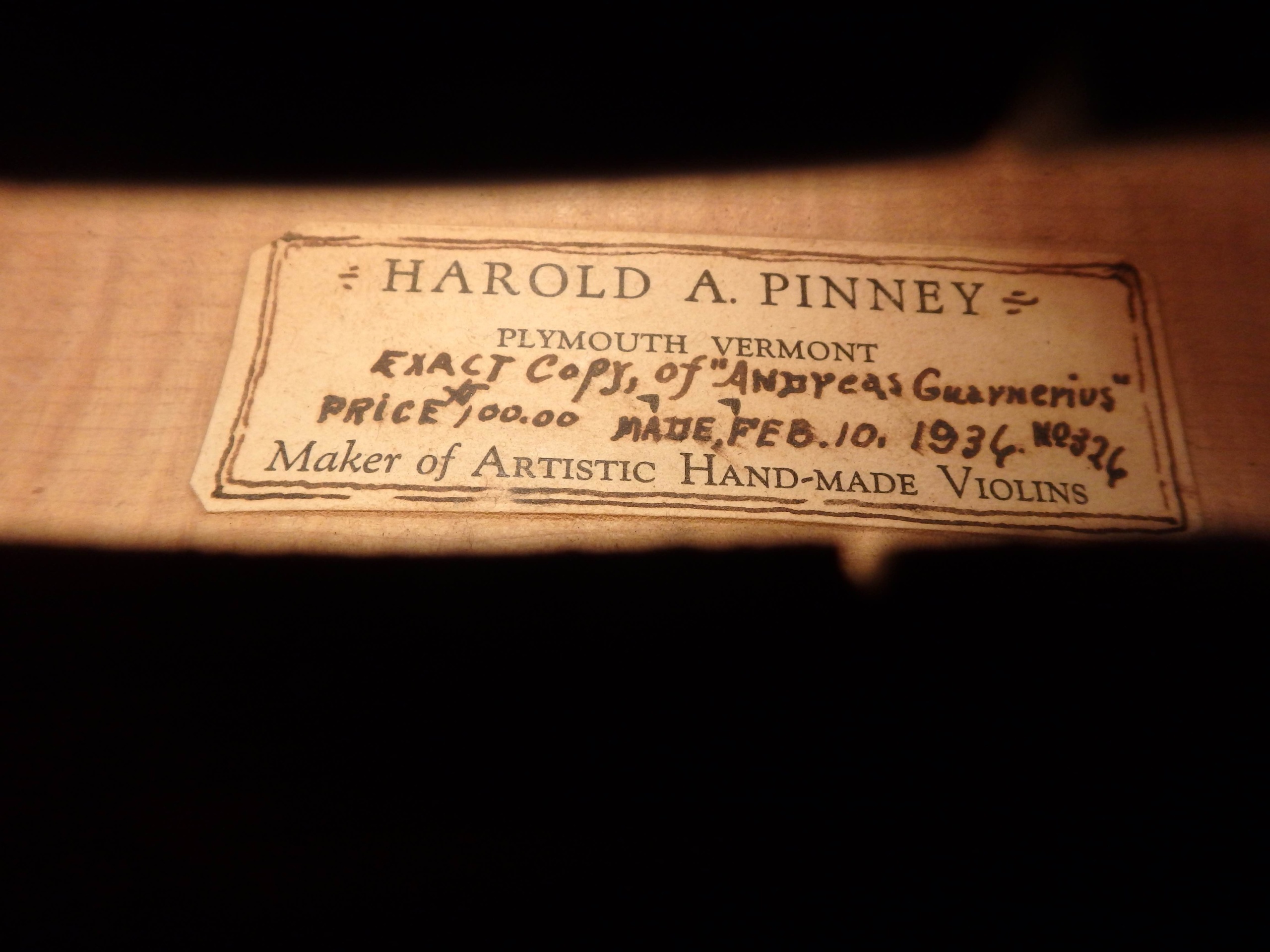
“Harold A. Pinney Plymouth, Vermont Maker of Artistic Hand-Made Violins. Exact copy of ‘Andreas Guarnerius’ price $100.00. Made Feb. 10, 1936 No. 326.”

J. R. Foster, Shelburne Falls, 1909
October 2025 T2: Lot 270
Who needs a label? J.R. Foster decided to do away with paper, and ink-stamped the image of a label onto the inside back of the violin – complete with a decorative border. I guess he figured it would be a lot harder to remove or swap. While the content itself is rather plain, it’s much more unusual to see the maker’s information inked onto the violin than printed on a label. Perhaps it was seen as a cheaper option than ordering a bespoke set of paper labels.
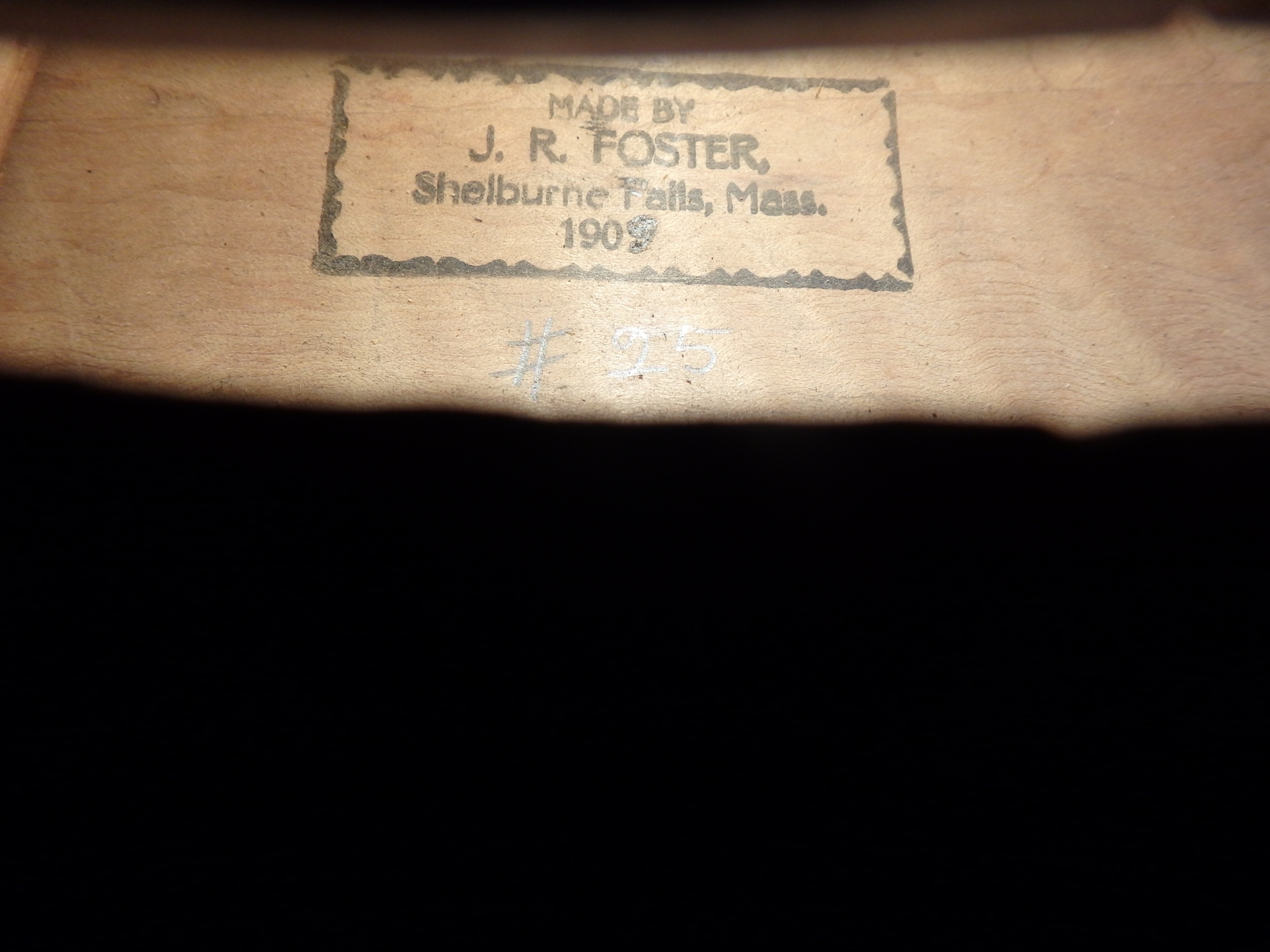
“Made by J. R. Foster, Shelburne Falls, Mass. 1909.”

William B. Knox, Utica, 1908 & August 2025 T2 Lot 298, John H. Ericson, Hammond, 1940
December 2025 T2
I was very amused to see that these two makers both made use of the f-hole shape in their labels. This is likely a coincidence, since I couldn’t find any established connection between the two of them. Either way, it’s interesting to notice that on both labels, the upper and lower sound-hole wings are the same width. Clearly, balanced design principles were more important than verisimilitude.
"WM. B. Knox. Violin Maker Utica, N. Y. Copy Vuillaume 1908 Mar - 25."

Harry Rockwell, Providence, 1932
December 2025 T2
Harry Rockwell also makes use of violin iconography in his label, dated 1932. The border’s use of not just one, but three aspects of a violin, as well as a cello head, is a charming and typical example of the branding through printing that we see throughout this collection.

Moise Potvin, Woonsocket, 1925
August 2025 T2: Lot 274
Before we get to Moise Potvin’s interesting label, it should be known that, in addition to making violins, he was an accomplished wood carver and sculptor whose work can be found in museums and has been sold at auction. We’re lucky to have a nice example of his lesser-known talent, violinmaking, with us to study.
Potvin relocated from Canada to Rhode Island as a teenager and seemed to have developed a love for his new home country. He hammered home his patriotism not only by letting us know the violin was made in America, but also by adding a title to the harp-imprinted sheet music, “America I Love You.” Could it be some sort of reference to the 1915 Archie Gottler tune of the same name? We may never know.
Potvin’s usage of the phrase “Honni soit qui mal y pense” is a puzzling one. Most famously known as the motto of the Order of the Garter, it was a phrase used to deflect negative interpretation of a situation, suggesting that it is unwarranted. We can’t know for sure why Potvin put this on his label. My hypothesis is that it has a connection to his Canadian origins, with its usage in certain military and parliamentary contexts.
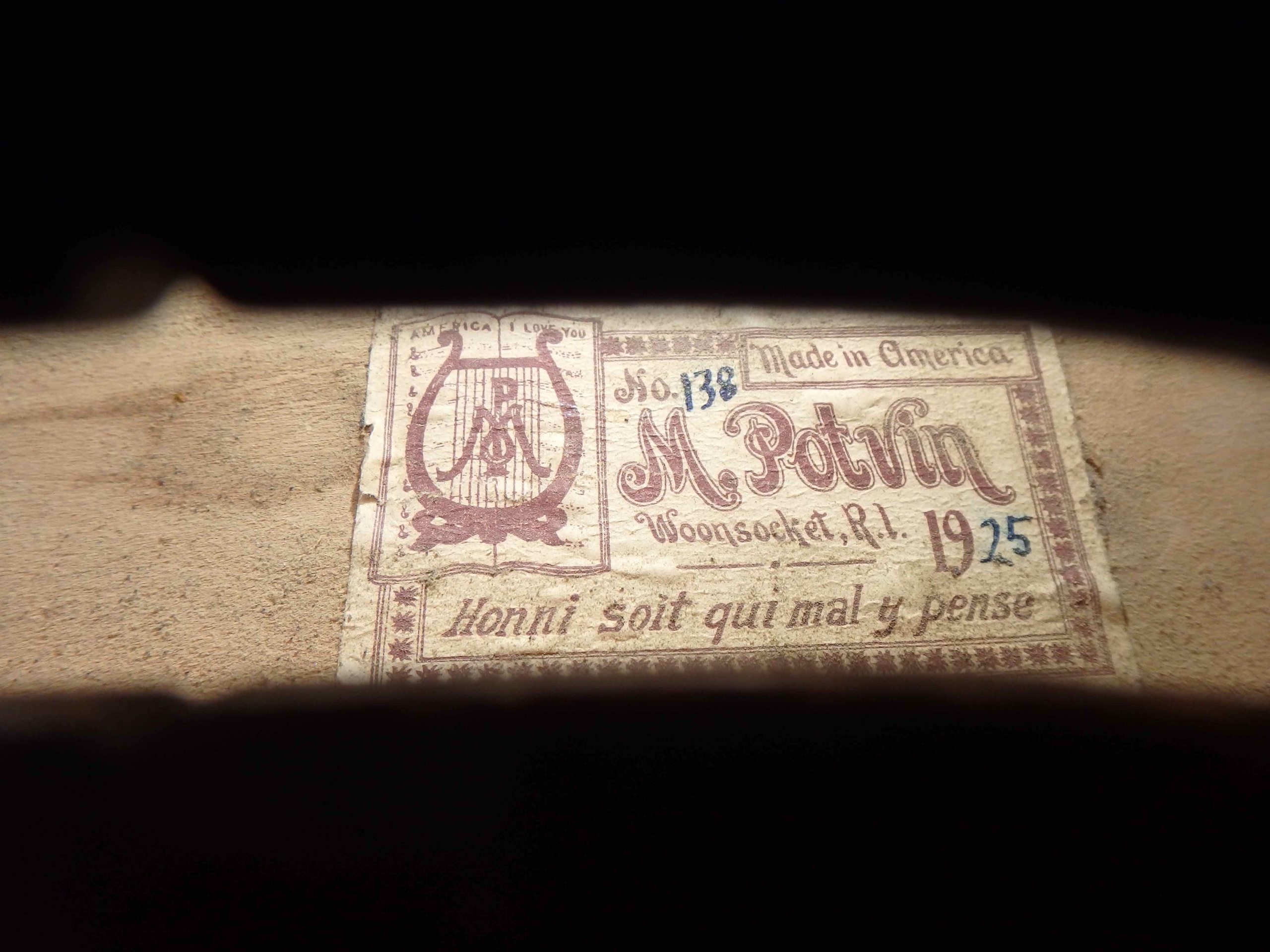
“M. Potvin Woonsocket, R.I. 1925 No. 138 Made in America. Honni soit qui mal y pense.”

Lloyd Kunkel, M.D., Weeping Water, 1949
October 2025 T2: Lot 315
Lloyd Kunkel’s label gives us a beautiful glimpse into the life of an amateur maker who treated his violin making as seriously as his primary career. While serving as a medical officer during World War II, Kunkel spent some of his time stationed in Italy. During his deployment, he rediscovered his boyhood interest in violins and perhaps, while in Italy, was exposed to instruments and instrument makers that inspired him. This violin, dated 1949, would have been among the first that he made upon his return home with his newfound knowledge and inspiration from his time in Europe.
I imagine that mentioning his credentials as a physician and surgeon elevated the perception of his fine motor skills. Sadly, the inverse – calling oneself a luthier on the window of a medical office – might be bad for business…
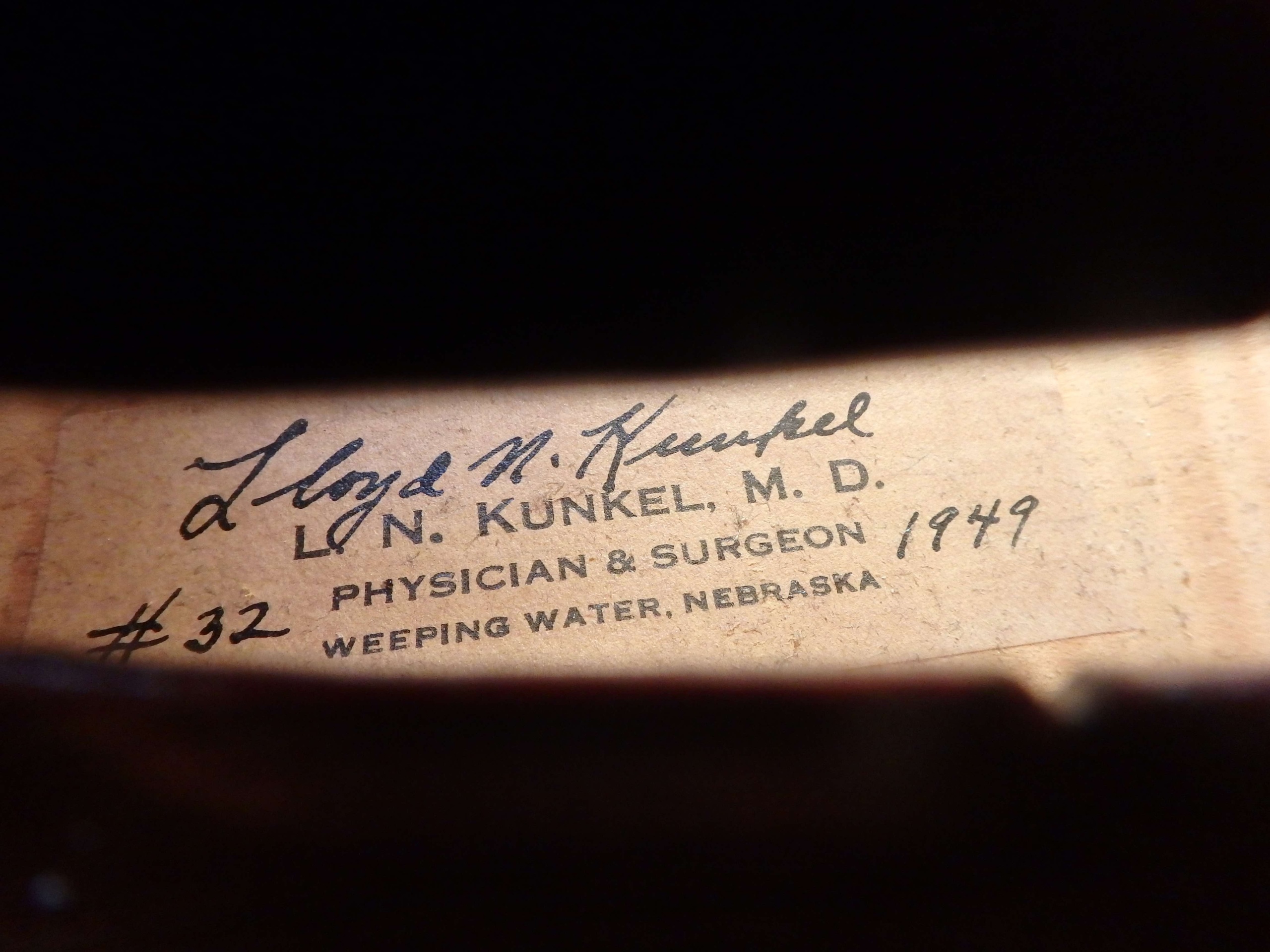
“L. N. Kunkel, M. D. Physician & Surgeon Weeping Water, Nebraska 1949 #32.”

The violins featured in this Carteggio are part of The David Bromberg Collection of American Violins. T2 will be selling the collection in our August, October, and December 2025 auctions. These sales coincide with the publication of the book of the same title, written by David Bromberg, Bruce Babbitt, Richard Dodson and Brandon Godman, published in conjunction with the Violin Society of America.
Sources
1. Lyle Elder Folk Art & Outsider Art
2. The Violin Makers of the United States by Thomas Wenberg
3. Conversations with Jason Price
4. Conversations with David Bromberg
5. Conversations with Bruce Babbitt
6. Conversations with Graydon Barnum
7. Nebraska Wesleyan University Magazine, Archways, Winter 2021-2022
![]()











